The Easiest Herbal First Aid Salve You Can Make Even if You Live in the City
This easy herbal first aid salve is made with common herbs you can grow anywhere. Using just three herbs, one that you can grow easily in a container or your flower garden, and two that you’ll find growing wild all over the world. If you aren’t up to foraging right now, you can find seeds and grow these herbs yourself, too.
I was in the local coffee shop last summer, enjoying an iced coffee when a tourist came in. Her finger was swelling. She had been stung by a bee while riding her motorcycle through town. She got an ice cube from the barista and was gingerly icing her swollen finger. I asked her if she would like some plantain for her sting. I knew that there would be some plantain growing just outside the Bistro in the vacant lot next door. I went foraging and brought her back a couple of plantain leaves in minutes. I explained to her that plantain would give her relief and she just needed to bruise the leaf and lay it on the bee sting. Within minutes the pain subsided and the swelling started easing. It was like magic. Other people in the coffee shop watched the transformation and became curious. It was a teaching moment about the healing miracle of herbs, even in the city.
Plantain is one of the herbs in this easy-to-make herbal first aid salve. It’s useful for injuries like bee stings, mosquito bites, slivers, and infections because it increases circulation and draws the venom out of bites and stings. It is a first-rate wound herb. While it’s great to be able to identify plantain in the wild so that you can use it as needed, it’s also good practice to use plantain to make an herbal first aid salve so you can have the healing virtue of this herb year-round and in a convenient form.
Making herbal first aid salve is a good way to tap into the healing benefits of the herbs you have growing in your own backyard. The herbs chosen for this recipe can be grown anywhere, even if you live in the city. You may even have some of these herbs growing wild in your neighbourhood. Check vacant lots, as I did.
Healing salves are often used for skin conditions, bruising, dryness, rashes, boils, and abrasions, but they can also be used to deliver warmth and anti-inflammatory actions to the body.
Salve making always begins with oil that’s been infused with medicinal herbs. You can make herb-infused oils during the growing season so that they will be ready for salve-making later in the season when you have more time. It is good practice to gather the herbs when they are fresh and dry them for making many different herbal preparations later in the season.

When to use an herbal salve
When someone in your family has a nick, scratch, bruise, sting, or swelling (as often happens when you have children or farmhands) wash the affected area with hot water, soap. Dry the area thoroughly.
Calendula, plantain, and yarrow ointment can be applied liberally as an herbal first aid salve. Use it several times a day for relief.
This herbal first aid salve is anti-fungal, antibacterial, anti-inflammatory, and encourages cell proliferation and healing. It may be used on sprains, bruises, and even small areas with broken bones (consult a doctor first). In a severe injury, this salve will support other therapies in healing your loved ones.
Properties of calendula for skin healing
Calendula officinalis, also called pot marigold, is a hardy annual herb that has a bushy habit and will become leggy unless you pinch it back. The flowers, stems, and leaves have a slightly sticky quality from a plant resin that contains anti-inflammatory properties, in addition to unique antioxidant compounds. Find out more about the healing virtues of calendula here. Gather the blossoms in August and September. It will keep blooming until you get a hard frost in your area. Dry the flowers in a basket lined with a paper towel, at room temperature.
Make an oil infusion by filling a quart jar with dried flowers and olive oil. Leave on a sunny window sill for 3 weeks. Strain the oil and reserve.
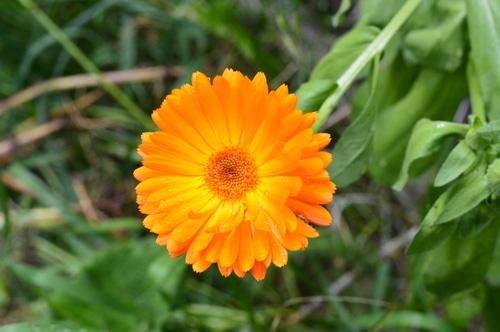
Properties of plantain for skin healing
Broadleaf plantain (Plantago major) grows in disturbed areas such as lawns, gardens, roadsides, ditches, and on the sides of creeks and streams. It was brought to North America by the Puritan settlers and was called “Whiteman’s footprint” by the First Nations due to its prevalence near settlements. Plantain’s main value is as a medicinal herb. It is used worldwide for herbal medicine and is one of the most accessible and abundant herbs. It is known for its wound healing activity, with anti-inflammatory, analgesic, and antioxidant properties. It also has weak antibiotic properties. You can find out more about the healing properties of plantain here.
You can also use narrow leaf plantain (Plantago lanceolata) in this remedy. Both varieties of plantain have similar virtues.
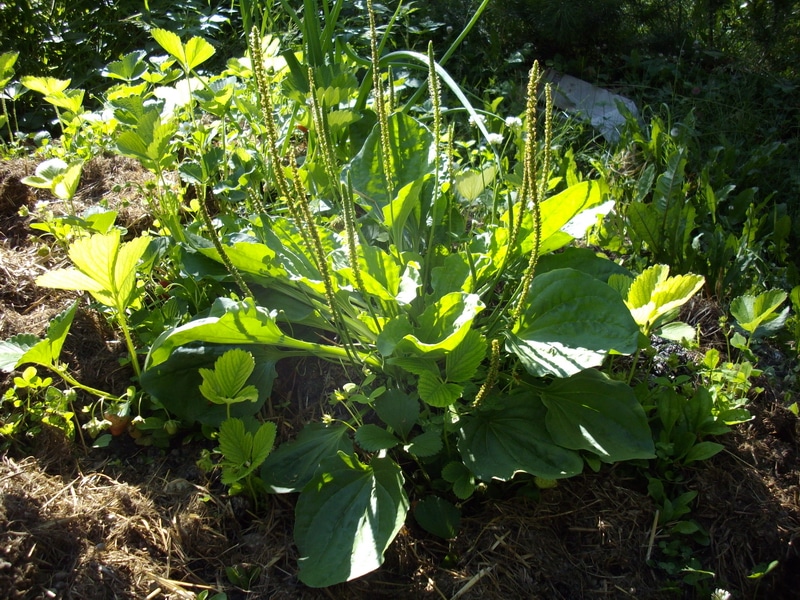
Properties of yarrow for skin healing
Yarrow (Achillea millefolium) has the ability to stop bleeding and makes an excellent styptic. A styptic is an astringent that stops bleeding. Yarrow styptic is anti-inflammatory, pain-relieving, antimicrobial, and wound healing so it is a good choice for shaving cuts, skinned knees, bleeding mosquito bites, and other minor wounds. It’s also one of the best remedies for bruising and swelling. Find out more about the healing properties of yarrow in this article. Use wild white or pink yarrow for salve making. These are higher in the active medicinal compounds than garden varieties of yarrow. However, if all you have is deeply coloured yarrow flowers like red yarrow, use what you have. The herbs growing in your own backyard will have the constituents that you need to thrive in your environment.
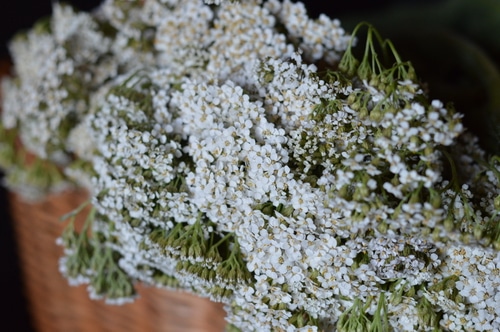
Step One – Infuse the Oils Using the hot process method
Method for infusing oils using heat:
Use 1 cup Organic Virgin Olive Oil or Organic Sweet Almond Oil to 1/2 cup of dried herbs (or 3/4 cups of fresh and wilted herbs). In this recipe, we’ll infuse the oils using a hot infusion process. (If you prefer to use a cold infusion process using this method for cold infusing oils and herbs. The cold-infusion process takes longer but requires minimal monitoring on your part.)
- If you are using fresh herbs, pick the calendula, plantain, and yarrow the day before you want to make the herbal oil infusion. Remove the leaves and flowers from their stems. Discard the stems. Allow the leaves and flowers to wilt overnight in an airy place. You can also use dried herbs for this herb-infused oil.
- To infuse the oil, place the herbs in a cloth bag. I use a muslin drawstring bag that’s 4 by 6 inches. Tie the top of the cloth bag, with a slip knot, to secure the herbs inside the bag. Make a double boiler using this method. Place the cloth bag inside of the glass measuring cup. Pour olive oil over the cloth bag inside the cup. Fill the saucepan with water so that the water reaches halfway up the side of the measuring cup. Simmer the water in the saucepan over medium heat.
- Simmer gently for one hour. While the herbs are heating in the oil, occasionally press the bag with the back of a spoon, to encourage the herbs to absorb the oil. Turn over the bag several times to encourage the herbs to release their goodness into the oil. Turn off the heat and set it aside.
- When the bag of herbs is cool enough to handle, press the bag of herbs to remove as much of the infused oil as possible. I use a potato ricer to do this. You can press with the back of a wooden spoon to get the oil out of the herbs.
- Store your infused oils in a dark container, in a cupboard until you’re ready for salve making.
Step 2: DIY healing ointment for cuts
This is the easiest first aid salve that you can make, requiring only the infused oil and beeswax.
Equipment:
- 2 x 2-ounce glass jar with cap
- glass measuring cup
- saucepan
- wooden stirring spoon or spatula
Ingredients:
- 7 tablespoons herb-infused oil
- 1 tablespoon of beeswax
Directions for making the salve:
- Make a double boiler using a glass measuring cup and a saucepan.
- Place the infused oil and beeswax together in the glass measuring cup. Heat the saucepan over medium heat till the beeswax melts completely.
- Remove from heat.
Pour the finished salve into 2 x 2-ounce (60 ml) tins or glass containers. Allow this healing salve to cool completely before covering with the lids. Label and date.
Herbal First Aid Salve will keep for 1 to 2 years when stored at room temperature in a cool, dark place. Keep it away from heat to increase the shelf life.
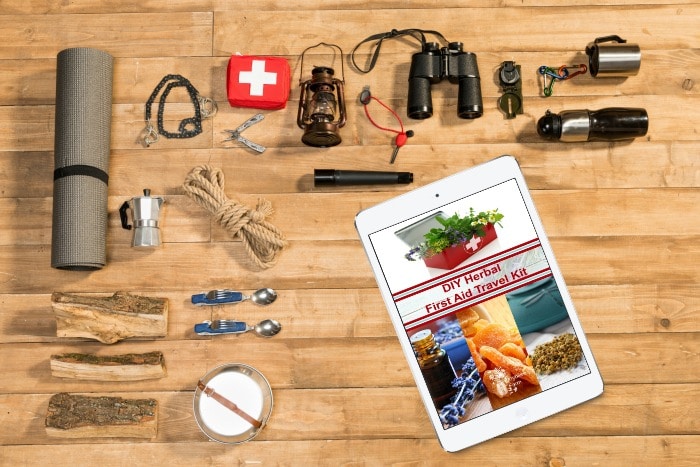
Build an Herbal First Aid Kit
In this post, you’ve learned about 3 of the best herbs for first aid: Calendula, Yarrow, and Plantain. You’ve also learned how to make an easy herbal first aid salve and if you followed the recipe, you’ve now got the first part of an herbal first aid kit AND you’ve gained freedom from Big Pharma and the industrial medical establishment, by making your own effective, natural medicine. Don’t stop there.
Join my VIP Members and get more information about healing herbs and how to use them effectively to help your family. You’ll learn more of the foundation skills that your great grandmother took for granted and you’ll be empowered in freeing self-reliance.
I have a FREE gift for you
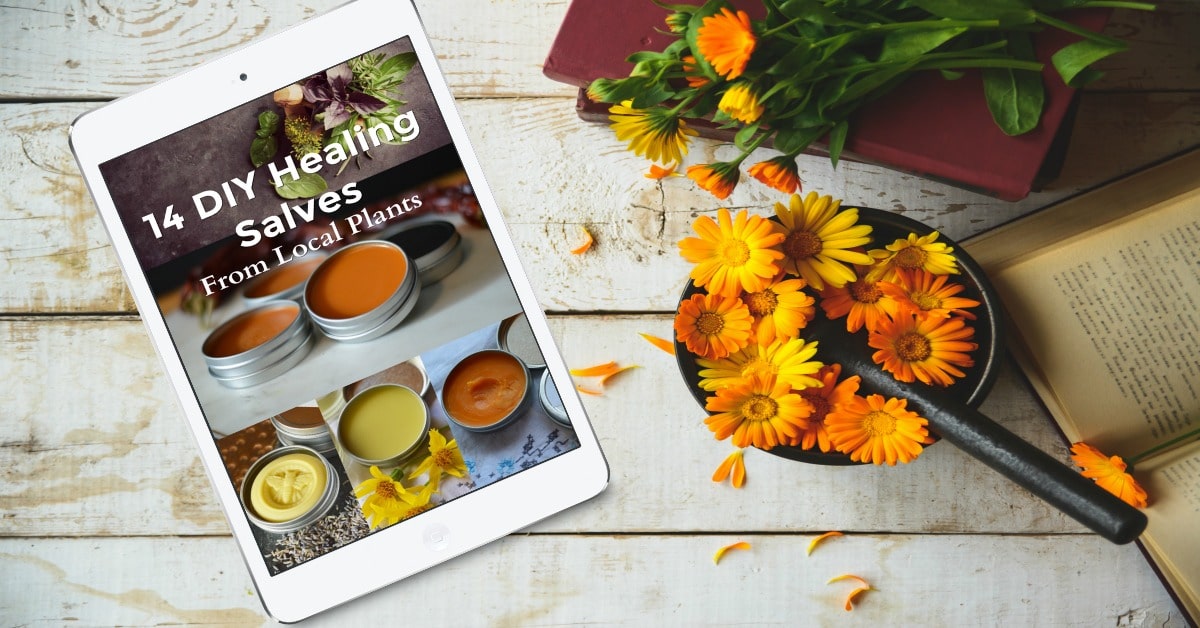
Grab my free ebook and learn to make DIY herbal healing salves at home now, with 14 easy-to-follow recipes that use the herbs and wild plants growing close to home. Salve-making is one of the easiest skills to learn in DIY Herbalism.


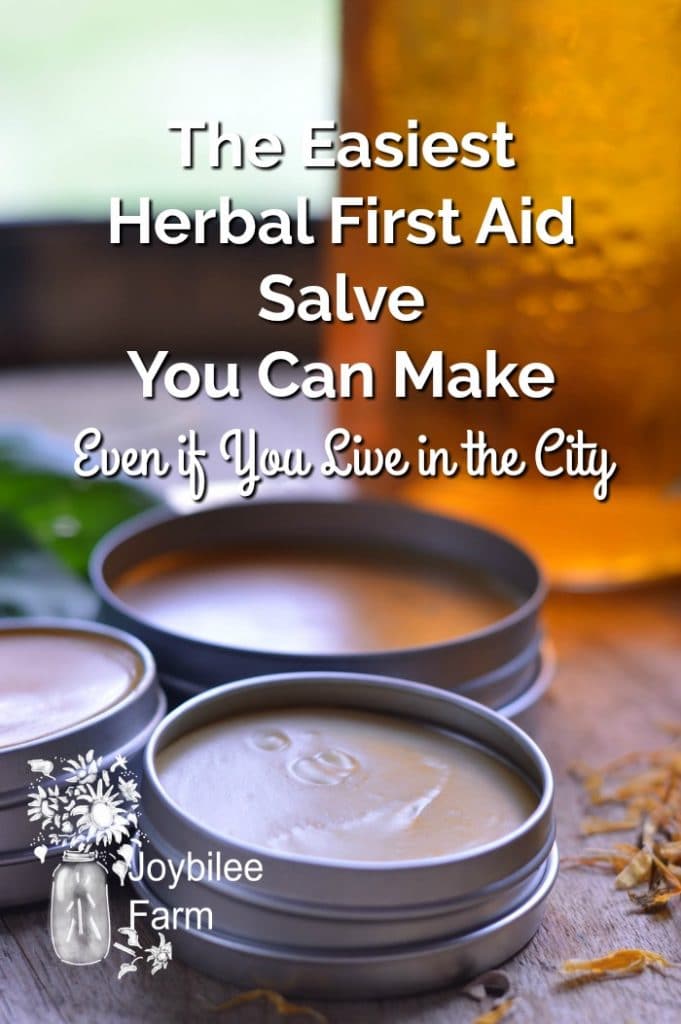

Awesome, Lois. That’s what I love to hear.
Hi Chris, Lots of plantain on my property, MORE than enough comfrey growing in the garden and lemon balm that has spread all over the yard, along with the oregano. I’ve got plenty of materials for salves and tinctures
I add lemon balm to my mix of yarrow, plantain and calendula for my healing salve. The lemon balm helps with cold sores.
That’s awesome. Every child on the planet should be taught this. Good job, Grandma!
My granddaughter was stung by a bee and my daughter pulled the butt and stinger from her leg. She sent me a photo of my granddaughter chewing up plantain and sticking it to her leg. The results? The sting almost invisible after 15 minutes, and a budding herbalist at age three who can treat herself.